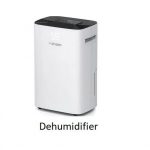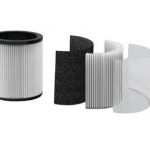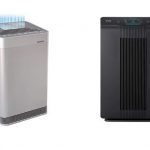Are Humidifiers And Dehumidifiers The Same
Due to the ever-changing climate, you may at one time need to use either a humidifier or dehumidifier. Both of them are household appliances that specifically deal with relative humidity. For those asking questions like “are humidifiers and dehumidifiers the same”. The simple answer for you is no.
Although they all deal with humidity, they totally perform opposite roles. Humidifiers work by adding moisture to dry air. But, dehumidifiers work by removing excess moisture from the air.
To highlight more about the differences between these units, we discuss when and how they can be used.
When To Use Humidifiers

If your surrounding climate is cold, then you may be experiencing low humidity levels. Under such circumstances, you need a humidifier. As highlighted above, humidifiers add moisture to the air to make it easier to breathe. According to scientists, the ideal humidity for healthy living should be between 30-50%.
Anything more or less can be harmful to your health. When the humidity goes below 30%, you may experience various side effects. For instance, dry skin, itching eyes, nosebleeds, snoring, and others. At this moment, you need a humidifier. Humidifiers can increase humidity to the required level to make you feel comfortable.
Humidifiers come in different types but they all work towards a common result. For instance, there is an ultrasonic humidifier, evaporator, impeller, and warm mist humidifier. These use a different mechanisms to generate moisture.
Pros Of Using A Humidifier
- Relieves asthma symptoms
- Alleviates sinuses and headache
- Prevents dry throat and nasal irritation
- Moisturizes cracked lips and dry skin
- Reduces snoring
- Prevents influenza
All these are rampant under low humidity, which is common in cold climates especially during winter. You only have to use a humidifier to avoid the effects of dry air.
When To Use Dehumidifiers

Dehumidifiers do the opposite of a humidifier. They remove excess moisture from the air. A good dehumidifier should be able to maintain a relative humidity of 30-50%. Some units come with a built-in humidistat that monitors the prevailing humidity level. You can preset your desired humidity and the dehumidifier will stop/resume functioning when it reaches minimum or maximum levels.
Pros of Using a Dehumidifier
- Reduces dust
- Prevents the growth of molds, dust mites, and other microorganisms.
- Reduces odor coming from molds and damp places
- Relieves allergy symptoms such as sneezing, wheezing, and chest pain caused by high humidity.
Should I Buy a Humidifier or Dehumidifier?
Before buying a humidifier or a dehumidifier, you should first determine the humidity levels around your home. You may use a hygrometer to read the current humidity. Besides, you may also guess your indoor humidity depending on your respiratory health. When humidity is high, you may start experiencing allergies triggered by molds and dust mites.
On the other hand, when humidity is low, you may experience itching eyes, dry skin, nosebleeds, and others.
So, depending on what you experience or get on your hygrometer you can make a decision. If you are using a hygrometer, you can get a humidifier if the humidity level is always below 30%. However, if the humidity level is always above 50%, you should get a dehumidifier.
Under some conditions, you may need both units installed. This is because some areas have fluctuating humidity. Humidity may increase or decrease and you may need either of the two at a certain time to avoid related effects.
But, you should note that the 30-50% humidity range is ideal for human beings. If you are dealing with plants or amphibian pets, the humidity range may differ.
Can A Humidifier Also Perform The Roles Of A Dehumidifier
No, as shown above, a humidifier and a dehumidifier are different. For that reason, non can perform the roles of the other. However, there are various humidifiers that are equipped with a dehumidifying function. These are designed as a 2-in-1 unit that can help control humidity when its high or low.
Maybe such units are the ones that confuse some people and they end up calling a humidifier and dehumidifier the same thing. Although these models are 2-in-1, you can only run them, one function at a time. For instance, you can either enable a humidification or dehumidification function at a time.
Therefore, even if you see a humidifier dehumidifier combo, it does not mean they are the same. This is just a technological advancement to ease the burden of owning two different units.
Our Take
Humidifiers and dehumidifiers are not the same despite both dealing with humidity. Humidifiers work by increasing humidity while dehumidifiers work by reducing excess moisture. This means they cannot work at the same time. If you want to use these devices for health reasons, you need to maintain humidity between 30-50%.
If your indoor humidity drops below 30%, you will need a humidifier to restore it. However, if it is higher than 50%, you will need a dehumidifier to reduce it.
In addition, these units yield different benefits. As highlighted above, dehumidifiers will help control condensation, growth of microorganisms, and musty odors, and can relieve some respiratory conditions. Also, humidifiers can help prevent the effects of dry air. For example, they can alleviate symptoms of eczema, pneumonia, dry eyes, nosebleeds, and others.
Basically, you can either use a humidifier or a dehumidifier at a time. They can never be used interchangeably. In a nutshell, your choice of using a dehumidifier or a humidifier depends on humidity levels.
Featured Posts
Latest Posts
- 5 Best Humidifier For COPD
- 5 Best Humidifiers For Greenhouse
- 5 Best Humidifiers For Electric Heat
- 5 Best Humidifiers For Pregnant Women
- 5 Best Humidifiers For Yoga Studio
- 5 Best Humidifiers For Eczema
- 5 Best Air Purifiers with Permanent Filters
- 5 Best Air Purifier With A Humidifier
- 5 Best Air Purifiers For Resin Printing
- 5 Best Air Purifiers for Eczema
- 5 Best Air Purifier With Fan Combo
- 5 Best Air Purifier For Lung Disease
- 5 Best Humidifiers For Essential Oils
- 5 Best Humidifiers for Elderly
- 5 Best Humidifiers For Lash Extensions
- 5 Best Humidifiers For Cough
- 5 Best Humidifiers For Fireplace
- 5 Best Humidifiers for Humidor
- 5 Best Humidifiers For Pets
- 5 Best Humidifiers For Weed



